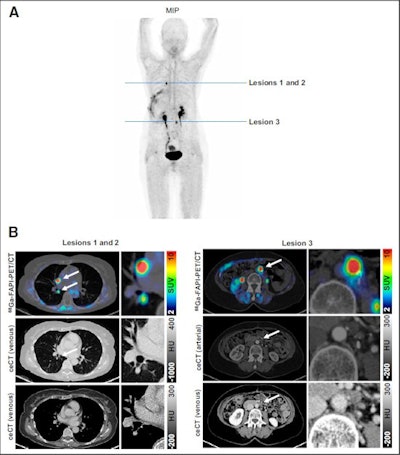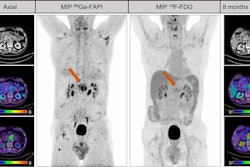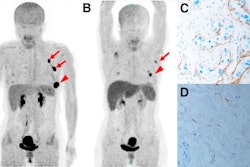Gallium-68 (Ga-68) FAPI-PET/CT imaging -- a highly accurate experimental approach for detecting cancer -- may further improve outcomes for patients undergoing radiation therapy, according to a recent analysis by German researchers.
A group led by Stefan Koerber, PhD, of Heidelberg University Hospital, found that the technique detected numerous malignant lesions not visible on standard imaging in 117 out of 226 patients and helped radiation oncologists plan more accurate therapy.
"More than half our cohort had a change in management due to findings on Ga-68 FAPI PET/CT that differed from [gold standard imaging]," the group wrote, in an article published September 7 in the Journal of Nuclear Medicine.
Considering that fibroblast activation protein (FAP) is highly expressed by stromal fibroblast cells in more than 90% of epithelial cancers, radiolabeled FAP inhibitor (FAPI) tracers have shown promising diagnostic performance for oncologic imaging, the group explained.
However, although its sensitivity for detecting cancers has been well reported, to date there is little information on the clinical impact of Ga-68 FAPI-PET/CT on oncologic patients, they noted.
To that end, the group aimed to evaluate the role of Ga-68 FAPI-PET/CT in managing a large group of patients with multiple types of solid tumors. They selected 226 patients who had undergone gold standard imaging primarily with contrast-enhanced CT and contrast-enhanced MRI, as well as FAPI-PET/CT scans within 100 days. Pancreatic cancer and head and neck cancers were the most common tumor types in the cohort.
The researchers noted that four Ga-68-labeled FAPI radiotracer variants had been used: FAPI-02 (21 patients), FAPI-04 (63 patients), FAPI-46 (101 patients), and FAPI-74 (41 patients) -- all PET tracers currently in various stages of clinical development, including phase III trials.
Specifically, they compared how the approaches performed in TNM staging, a system used to classify cancer prior to treatment based on the size of the primary tumor (T), its involvement in nearby lymph nodes (N), and whether it has metastasized (M).
 (A) Maximum-intensity projection (MIP) of Ga-68 FAPI-PET. (B) Axial Ga-68 FAPI-PET/CT images and contrast-enhanced CT images of suggestive lesions (arrows: lesions 1 and 2, pulmonary metastasis and mediastinal lymph node metastasis; lesion 3, paraaortic lymph node metastasis) detected by Ga-68 FAPI-PET. HU (Hounsfield units). Image courtesy of the Journal of Nuclear Medicine through CC BY 4.0.
(A) Maximum-intensity projection (MIP) of Ga-68 FAPI-PET. (B) Axial Ga-68 FAPI-PET/CT images and contrast-enhanced CT images of suggestive lesions (arrows: lesions 1 and 2, pulmonary metastasis and mediastinal lymph node metastasis; lesion 3, paraaortic lymph node metastasis) detected by Ga-68 FAPI-PET. HU (Hounsfield units). Image courtesy of the Journal of Nuclear Medicine through CC BY 4.0.According to the analysis, for 42% of all patients, the TNM stage was changed by Ga-68 FAPI- PET/CT results. Most of these changes resulted in upstaging, which is a reclassification of the cancer as more severe.
Moreover, based on a chart review by three of the authors, changes in clinical management due to additional findings on Ga-68 FAPI-PET/CT occurred in 117 of 226 patients, with major treatment changes accounting for 12%. In general, the highest clinical impact of Ga-68 FAPI -PET/CT imaging was found in patients with lung cancer, pancreatic cancer, and head and neck tumors.
"This study demonstrated that Ga-68 FAPI-PET/CT impacts both TNM staging and oncologic management in a high percentage of cancer patients with a variety of cancer types," the group wrote.
While including four FAPI radiotracers instead of one in the analysis may have created additional variables, most of the agents appeared to perform similarly, which reduced this factor as a limitation, the authors added. Also, because 100 days passed between gold standard and FAPI-PET imaging, the authors noted that in some patients, the differences in TNM staging might have been due to actual disease progression.
Thus, they said, the results should be considered preliminary.
"These results provide a basis for prospective randomized trials that can provide level 1 evidence of the value of Ga-68 FAPI-PET/CT," the group concluded.
The full article can be found here.





















